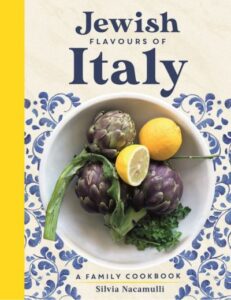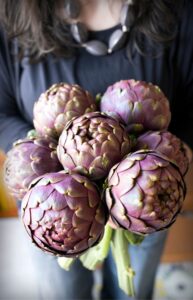With the High Holidays, Sukkot, Shemini Azeret and Simchat Torah upon us, many Jewish people can’t help but think about food, from what they’ll eat (apples and honey, challah) to what they won’t (when fasting for Yom Kippur) and where they may be sharing those foods with loved ones (a Sukkah). A lot of the traditions and dishes we have in North America are Ashkenazi-based since the majority of Jews here had ancestors who made their way from Eastern Europe.
 But what you may not know is that Jewish and Italian foodways have also been entwined for centuries. That history, the distinctive ingredients used by Jews and what the different waves of Jewish immigration brought to the country, are explored in the new collection, Jewish Flavours Of Italy, A Family Cookbook by Silvia Nacamulli.
But what you may not know is that Jewish and Italian foodways have also been entwined for centuries. That history, the distinctive ingredients used by Jews and what the different waves of Jewish immigration brought to the country, are explored in the new collection, Jewish Flavours Of Italy, A Family Cookbook by Silvia Nacamulli.
A cook, lecturer, and food writer, Nacamulli grew up in Rome surrounded by three generations of Italian Jewish cooks. As the product of two peoples obsessed with eating, the pleasure and joy she experiences from simple recipes come across doubly so. Nacamulli brings the warmth of the weekday lunches and Sabbath dinners her extended family shared every week to the page. And if you like to look more than cook, the sumptuous, vibrant photos will transport you.
Jews have had a presence in Italy for more than 2,000 years, dating back to the Roman-Republic (Jews of the “Italian Rite”) and Rome, Nacamulli explains, has “the oldest continuous Jewish community in the Western World.” The first to land in Italy, in fact, were descendants of Judah Macabee. The Sephardic Jews were the next to come: those who fled Spain, Portugal and other regions during the Inquisition. The most recent arrivals are the Libyan Jews, who emigrated after the 1967 War.
Nacamulli has gathered recipes that feature different cultures, flavors, and stories. The Jewish dishes of Italy place an emphasis
on vegetables, largely because the cooking was poverty-based, owing to Italy forcing Jews into ghettos beginning in the 16th Century, which would last 300 years). If there’s one food that could claim to be Italy’s signature one, it’s the artichoke, specifically Carciofi Alla Giudia, the fried artichoke. Preceding the recipe, Nacamulli gives step-by-step instructions on how to clean an artichoke, a critical lesson.
But if you’re not a fan, tempt yourself with the Caponata di Melanzane alla Giudia (aubergine or eggplant, the “vile” food of Italian Jews) or for the carnivores who want a taste of Libyan fare, the Lubia bel Cammun (braised beef), or for your sweet tooth, the Torta di Nocciole (Flourless & Butterless Chocolate Cake). In these recipes you’ll likely taste pine nuts or fennel or cinnamon or almonds, ingredients Jews put to use from their earliest days when they made a new home in Italy.
Open Jewish Flavours Of Italy and savor the rich culinary history of the Jews of Bel Paese (the beautiful country).


